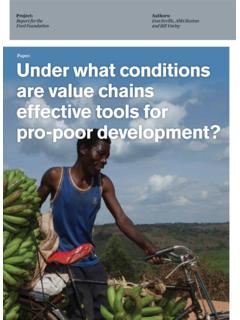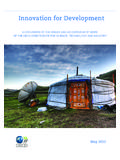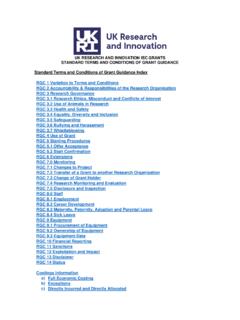Transcription of VALUE CHAIN DEVELOPMENT - International Labour …
1 ILOs work on VALUE CHAIN DEVELOPMENT (VCD) focuses on promoting pro-poor growth and job creation. The VCD briefing papers series explores technical areas in which the ILO has specific knowledge and capacity to offer, contributing new pathways towards Decent CHAINDEVELOPMENTILO VALUE CHAIN DEVELOPMENT Briefing paper 1:Combining VALUE CHAIN DEVELOPMENT and Local Economic DevelopmentValue CHAIN DEVELOPMENT (VCD) can support pro-poor DEVELOPMENT and job creation through strengthening enterprises, business relationships, improving market structures and the business en-vironment. It can assist in developing local micro and small enterprises and help in overcoming con-straints such as poor market access and little bar-gaining power. Often these constraints arise out of specific local conditions. For example, one of the major problems faced by the fish-breeding sector in Sri Lanka was a lack of dialogue with farmers and the local administration leading to a conflict on water usage.
2 In order to solve this conflict a local solution involving improved dialogue and a new lo-cal regulation of water usage were needed. A local economic dialogue forum set up in the province solved the problem, enabling VALUE CHAIN deve-lopment. Combining a VCD approach with a Local Economic DEVELOPMENT (LED) mechanism made a solution possible. VCD and LED approaches can reinforce each other. Both are approaches that address the how to of private sector DEVELOPMENT and that can be designed to include the poor in the resulting bene-fits. VCD seeks to enhance the functioning of the market system by analyzing it and devising inter-ventions to overcome bottlenecks and constraints in the CHAIN . LED strategies identify the economic potential of a specific territory and empower local economic actors to take joint action for economic growth and job creation. By combining the approa-ches possible shortcomings of each single way of doing things can be avoided.
3 One of the strengths of a VALUE CHAIN approach is its understanding of boundary-crossing nature of economic processes. VALUE chains are rarely limi-ted to one particular area, but they often cross lo-cal and national borders. On the other hand VCD practitioners may fail to give enough importance to local conditions such as cultural norms and behaviour, local red tape and local constraints to infrastructure development2. Understanding the local context is often crucial in order to address underlying constraints of local market systems: Local Economic DEVELOPMENT is a participatory DEVELOPMENT process that encourages partnership arrangements between the main private and public stakeholders of a defined territory, enabling the joint design and implementation of a common deve-lopment strategy, by making use of the local resour-ces and competitive advantage in a global context, with the final objective of creating decent jobs and stimulating economic activity 1.
4 The ILO has been working on LED since the mid 1990s building on a long tradition of facilitating inclusive public-private dialogue. The knowledge and practice of the ILO in LED has been documented on ILO LED definition: Canzanelli, G.(2001), Overview and learned lessons on Local Economic DEVELOPMENT ,Human DEVELOPMENT , and Decent Work, Universitas working paper, ILO, 2 VALUE CHAIN interventions will be impinged given a non-enabling local environment or misperceived lo-cal conditions. LED s focus on one particular geo-graphic area enables localized solutions and, thus, combining VCD with LED can help to find solutions adapted to the local context and owned by local populations. Furthermore, LED s link to local gover-nance and DEVELOPMENT planning can enhance the cross-sectoral dimension of VCD. A VALUE CHAIN describes the full range of activities that are required to bring a product or service from conception, through the intermediary phases of production (.)
5 , delivery to final consumers, and final disposal after use. 3 This includes activities such as design, production, marketing, distribution, and support services up to the final consu-mer (and often beyond, when recycling processes are taken into account). VALUE chains are part of Market Systems 4 (see image). At the centre of the Market System are the VALUE chains that bring products and services to the market. The immediate environment is formed by supporting functions (such as business DEVELOPMENT services and finance) and rules and regulations relevant to the CHAIN (including Labour rights). The broader environment around this affects the immediate environment as well as setting its own sectorInformalnetworksGovernmentSUPPORTI NG FUNCTIONSRULES & REGULATIONSW orker/employeemembershiporganizationsBus iness membershiporganizationsNot-for-profitsec torStandardsLawsInformal rules& normsCoordinationR&DInformationSkills & capacitiesRelated servicesMARKET PLAYERSVALUE CHAINI nforming & communicatingSetting & enforcing rulesInfrastructureRegulationsSourcingPr oductionMarketingPrivate sectorInformalnetworksGovernmentSUPPORTI NG FUNCTIONSRULES & REGULATIONSW orker/employeemembershiporganizationsBus iness membershiporganizationsNot-for-profitsec torStandardsLawsInformal rules& normsCoordinationR&DInformationSkills & capacitiesRelated servicesMARKET PLAYERSVALUE CHAINI nforming & communicatingSetting & enforcing rulesA better understanding of local contexts as provi-ded by an LED approach can help avoiding pitfalls in
6 Key issue in VALUE CHAIN DEVELOPMENT is to under-stand the importance of final demand. Buyers want to buy high quality products at competitive prices with short delivery times and flexible responses to their orders. Understanding the exact nature of 2 Schoen, Christian. 2011. Green production and trade to increase income and employment opportunities for the rural poor. Strategy for Implementing LED Process in 2011 and 2012, Vietnam. International Labour Kaplinsky, R. 2004. Spreading the gains from globalisation: what can be learnt from VALUE - CHAIN analysis, Problems of economic transition, vol. 47, no. 2, pp. 74- 1154 Source: VALUE CHAIN DEVELOPMENT for Decent Work (2009), page 33 Ornamental fish VALUE CHAIN upgrading in Sri LankaThe Enterprise for Pro-Poor Growth (Enter-Growth) was a four-year project of the International Labour Organisation (ILO), the Swedish International DEVELOPMENT Agency (Sida) and the Ministry of Enterprise DEVELOPMENT and Investment Promotion.
7 It was implemented in 4 Sri Lankan districts between 2005 and 2009. One of the sectors the project intervened in was the ornamental fish sector that has po-tential to contribute a lot to the district s economy, but the VALUE CHAIN was underdeveloped. The biggest problem was a long lasting conflict on water usage between fish gro-wers and paddy farmers. The water in the district was reserved for paddy farmers and the farmers associations had blocked water to the fish-breeding ponds. As a result of the conflict, DEVELOPMENT of the ornamental fish sector had stopped as well as its potential to create decent work and better incomes. Moreover, there were not enough suppliers of inputs to meet the growing demand hence the prices were high. Breeders lacked technical skills on fish breeding. They had low know-how about how to combat diseases. Market ac-cess was an issue because of transportation problems, cumbersome security checks and sometimes road blocks.
8 Furthermore, because they were not organized it was dif-ficult for growers to lobby or make a strong voice to nego-tiate for higher prices. The ILO s Enter-Growth project interventionsA key structure set up by the project was a set of District Enterprise Forums based on an LED approach. These fo-rums constitute bodies for dialogue on enterprise deve-lopment and their members are district authorities, public sector business DEVELOPMENT organisations, chambers, small business associations and NGOs. In Polonnoruwa the district forum was part of the solution for the conflict on these demands is crucial for VALUE CHAIN develop-ment. Effective cooperation and communication among the stakeholders of a CHAIN are key to en-hance its responsiveness to end market demands. The needed dialogue between stakeholders can be enhanced by LED approaches that typically focus on participation and social dialogue.
9 Therefore, by improving stakeholder communication, LED can improve the knowledge flow along VALUE chains and make VALUE chains more effective and inclu-sive. LED might also provide an avenue to support local innovations that can enhance VCD LED s focus on participation and dialogue can add VALUE to VCD, participation is not always enough for effective intervention. Finding an agree-ment can be slow and consultations with stakehol-ders can produce more questions than answers. At times, LED as an approach has received criti-cism on putting too much emphasis on strategy and planning instead of action5 . LED practitioners might also fail to take into account the importance of VALUE CHAIN players outside the local territory. Local producers need to be connected to national and global buyers. If VALUE chains are not fully un-derstood, local actors might not be aware of the importance and specific nature of final demand.
10 This can lead to an underestimation of the impor-tance of the factors that are pulling the rest of the CHAIN , end market demand. It could also lead to underestimate the important role of large buy-ers in many VALUE chains. Here a VALUE CHAIN per-spective can deepen the understanding of markets and strengthen the market analysis tools in de Ruijter de Wildt, Marieke et. al. 2006. Making Markets work for the Poor. Comparative approaches to private sector DEVELOPMENT . Swiss Agency for DEVELOPMENT and Cooperation and LED approaches can complement each other. Figure 1 and 2 graphically present the rela-tion between LED and VCD. In figure 1 the arrows between nodes represent vertical linkages of a VALUE CHAIN , in which busines-ses trade products and services6. VALUE chains are sometimes misunderstood to be focused only on these vertical business to business links in the CHAIN .



















